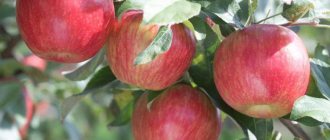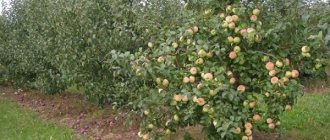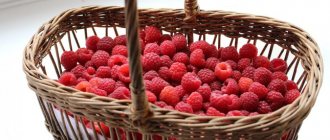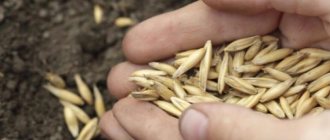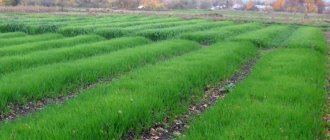Advantages and disadvantages
Rye as a green manure has many advantages:
- seeds are inexpensive;
- the plant produces a large amount of green mass, which, after mowing and plowing into the soil, rots and becomes food for vegetable and other cultivated plants;
- Rye can be sown in regions with cold climates, as it is not afraid of low temperatures and germinates early.
The plant has long powerful roots that penetrate deep into the soil and pull nutrients from the lower layers. After the green mass rots, microelements become available to plants that will grow in the area after green manure. The roots make the soil loose and airy, preventing the appearance of diseases and pests.
Sowing winter rye on green manure in the spring has the advantage that the plants do not throw out ears for a long time, but form a thick green mass. In terms of nutritional value and impact on the soil, the crop is comparable to humus, so it can be used as a replacement for manure. This option is relevant for those gardeners who find it difficult to obtain organic matter, but still want to improve the soil on their site.
Rye, like green manure, sown in the fall, protects the ground from freezing, and if it is mowed before winter and incorporated into the soil, it has time to rot before spring. Early crops can be planted in such a plot. Green manure sown in spring can be mowed several times a season if you leave the area to rest from vegetables and grow only green manure on it during the season.
Rye has few disadvantages; for example, some gardeners do not like the fact that they need to monitor when the plants begin to throw out ears in order to mow them in time. This is especially true for rye sown before winter in the fall. Another feature of rye that needs to be remembered is that it attracts click beetles; their larvae, wireworms, live in the roots of plants. To solve this problem, rye is sown in a mixture with mustard, which pests do not like.
How to use rye as fertilizer
Rye (cultivated) is a herbaceous annual or biennial of the Poaceae family. The genus includes wheat, oats, rye, corn, barley, millet and sugarcane.
Rye is classified as a cultivated plant that has two forms - spring and winter.
Fertilizer helps to realize “unavailable” phosphorus accumulated in the soil (for example, when using bone meal). When planted in autumn, rye on its roots supports the growth of a huge number of mycorrhizal fungi. Fungal roots-mycorrhizae process and make available nutrients (especially phosphorus).
Rye is used primarily for the development of soil microflora and the propagation of mycorrhizal fungi.
Plowing rye in spring has a beneficial effect:
- on feeding the soil with soil organic substances;
- for future plantings - provides plants with phosphorus elements.
Features of application
Cold-resistant rye survives even in frosty winters. The culture grows in any soil, even depleted soil. It is sown in dried swamps, sandstones, and wastelands.
Rye loosens sandy and hard clay areas, and protects lighter soils from weathering.
It is recommended to sow rye for the development and development of new land (it quickly clears the area of weeds).
Tolerates arid climate. Thanks to its fibrous, powerful root system (the roots go deep at a distance of more than 1 m), rye stores moisture and uses it rationally later. About sprouts after winter.
The optimal soil type for rye is a weak to medium (neutral) pH level. Although it normally tolerates areas with low salinity.
When and how to sow green manure
Sowing can be done both in spring and autumn, but it is still preferable to sow winter rye as green manure in the fall, after harvesting the previous crop.
Sowing begins in different regions from the 2nd half of August and continues until the end of September. You can sow later, but no less than 1-1.5 months before the onset of cold weather. In the spring, sowing should be done as early as possible; you can sow immediately after the snow melts; rye is not afraid of cold weather and will be able to make good use of the winter moisture in the soil. If you sow later, with the onset of noticeable warmth and heat, the plants will have to be watered, which is not always convenient.
Rye as green manure is sown in 2 different ways: in rows with a row spacing of 15 cm or in a continuous method. Seeding rate – 2 kg of seeds per 100 sq. m. They are buried by 3-5 cm; they can be buried deeper in light sandy soils than in clay soils. If the soil is dry, then the area should be watered during planting, sprinkle the seeds with a layer of soil and lightly tamp.
In a greenhouse, you can also use rye as a green manure to improve soil fertility. The sowing time in the fall is approximately the same as in open ground; in the spring you need to sow 2-3 weeks earlier so that you can plant vegetables in the greenhouse earlier. If you plant rye in a greenhouse before winter, then it needs to be covered with fallen snow so that it does not freeze in winter.
Positive aspects of cereals as green manure
The price of cereal seeds is negligible. For pennies you can buy a bucket of grains, which is enough for 5 acres of land. And there will be enough green mass from five acres that you can fertilize a plot of half a hectare if you use the mowing method. Mowing is cutting off greenery and using it in other beds. The roots remain in the soil and serve as additional fertilizer.
Rye is a picky plant and can grow in any type of soil. Regular watering is required, since the root system of rye is fibrous. This is a bunch of thin roots that loosen the soil well, but penetrate into it shallowly and cannot get moisture from the depths.
Rye is one of the most frost-resistant green manures, which allows it to overwinter under the snow and in the spring continue to grow and gain green mass. The winter variety is planted at the end of September or even in October. Autumn plantings are not mowed, but the seedlings are allowed to go under the snow.
If you sow winter rye in the spring, it will grow longer. Planting vegetables will have to wait, which is not always profitable. Therefore, summer residents try to harvest the crop and immediately sow the bed with rye grains in order to get plants up to 30 cm high by spring.
The branched root system grows quickly, faster than the weeds from which it takes nutrients. If after cleaning the area you sprinkle it with mineral fertilizers, the effect will be even better.
Winter rye is mowed several times in spring and summer, leaving the roots in the ground. Thus providing plants with nutrition for the entire growing season. After all, rye can not only be embedded in the soil for rotting, but also made into green liquid fertilizer for watering seedlings.
Video: Rye as green manure - gardener reviews
All useful substances pass into the water and quickly reach the roots of vegetable crops. Raspberries, which have a shallow root system and are very dependent on the availability of nutrients in the upper fertile layer, will be especially grateful for such watering.
Another positive property is that it is suitable for all plants, based on the principles of crop rotation. Cereals are not grown in summer cottages, so they are quite suitable as an intercrop for legumes or cruciferous plants - cabbage, radishes, radishes.
Care measures
At the beginning of their growth, green manure in the garden needs watering, but only if there has been no rain for a long time and the soil has dried out. Watering must be taken responsibly, especially in arid regions. If at the beginning of growth the plants feel a lack of moisture, they will not be able to get much greenery. Once their roots have grown sufficiently long, they will no longer need to be watered. There is no need to fertilize cereal plants with anything, but you can add fertilizers to the soil before planting, for example, nitroammophoska in the amount of 20 g per 1 sq. m. m.
When to plant and dig up rye crops with soil
The winter variety is planted at the end of August, immediately after harvesting the vegetables. Until November, rye crops gain green mass. Then you can do as you wish:
- Trim the greens with a flat cutter and dig them to a depth of about 10 cm for rotting.
- Leave on the surface of the soil without digging. With the onset of spring, decomposed greenery will fall into the ground.
- Do not mow the green mass in the fall, but leave it to grow until spring. This is the most popular method - it is recommended by gardeners who actively use green manure to restore the soil.
The method without digging has another advantage: digging causes the death of soil microorganisms that live at different depths. If the upper and deeper layers are swapped, the beneficial microflora will not be able to survive. In addition, bacteria die from exposure to ultraviolet radiation - they prefer to live in the dark. It will take a long time to restore the population of beneficial bacteria – up to 3 years. Or buy special preparations containing microorganisms.
In developed countries, the use of mineral fertilizers and chemicals when growing vegetables and fruits is gradually prohibited. Farmers are switching to more natural methods of increasing fertility - green manure and bacteria.
Many summer residents continue to dig the ground, thinking that this is how they loosen it. But green manure does this more effectively. After all, roots that decompose in the soil leave behind channels into which water and air penetrate. This makes the soil softer and more moist. In addition, bacteria are preserved, for which plant components serve as food.
To incorporate green fertilizer into the soil in the spring, just grind it with a flat cutter directly into the soil, water it and wait one and a half to two weeks for the plant residues to decompose. After two weeks, you can plant vegetable seedlings. You can speed up the decomposition process with EO preparations diluted in water to the required concentration.
Important advice for autumn planting: empty fields and beds are inhabited by birds. If you leave the grain uncovered, the crows will eat it. Therefore, it is recommended to sow rye to a depth of about 3 cm. On sandy loam soils - up to 5 cm. On clay soils 1 - 2 cm, so that seedlings break through to the surface faster and easier.
Optimal timing of mowing green mass
The time to mow and dig up rye comes when the plants reach the stage of throwing out an ear. At this age, they have already managed to build up enough mass to be enough for fertilizer, but have not yet become coarse. Afterwards, the shoots and leaves of the rye become rough and take longer to rot in the ground.
The minimum period for rotting of mown green mass in the soil is 2-3 weeks, so it is necessary that the interval between planting rye in the soil in the spring and planting a crop in its place should not be less than this period. Typically, green manure is harvested in March-April in the spring, and before the onset of cold weather in the fall. By the time of mowing, the plants should have grown to a height of approximately 30 cm.
What can be done with rye: plant it in the soil to a depth of 8-15 cm, leave it on the surface as mulch, or leave it to overwinter until spring.
Which plants are suitable for rye as green manure?
Due to the large amount of nitrogen, rye is used as a precursor to potatoes, tomatoes, cucumbers, and melons. These are the plants that need nitrogen supplements for full development. But potatoes are damaged by wireworms, which are undesirable to attract to the site, so rye is combined with mustard before potatoes.
Under fruit trees, rye must be watered frequently so that the fruit yield does not decrease due to lack of moisture. Joint planting of cereals and vegetables is not recommended, as the rye will take away water and nutrients.
Advantages and disadvantages of using rye as green manure
The following positive qualities of rye :
- does not require special growing conditions;
- affordable;
- unpretentious, can grow on any soil: acidic, sandy, depleted;
- the branched root system allows you to extract the necessary nutrients and make them easily digestible for other plants;
- After this crop, you can plant many vegetables: potatoes, tomatoes, zucchini, cucumbers;
- repels various pests, such as nematodes;
- destroys harmful bacteria and microorganisms;
- when planted two years in a row as a green manure, it is capable of suppressing the growth of some weeds (birch, wheatgrass);
Among the negative aspects of the cereal crop, such a property as drying out the soil is noted. Therefore, during drought, be sure to water the plantings.
Important! Rye should not be planted between trees or garden crops, as this can lead to a decrease in their yield.
Do not forget about timely harvesting of crops from the site . If you bring the grain to heading, the greens will become coarse and will be very difficult to cut and chop.
Reviews
Many summer residents believe that it is better to sow rye as green manure in the fall . This enriches the beds with nutrient compounds exactly when the soil needs it most.
Vladimir, Nizhny Novgorod : “Rye suppresses the growth of weeds until spring, unlike manure. It contains many weed seeds that are not digested by the gastric juice of animals and penetrate into the ground in their original form. You can only get rid of them by composting, and this takes a whole year.”
Maria, Orel : “Green manure sown in autumn can be quickly incorporated into the ground and provide excellent green fertilizer for future plantings. The plants take about three weeks to partially decompose in the soil.”
Mikhail, Novokuznetsk : “Nematodes and pathogenic microflora practically do not live in those places where rye grows. During the winter, the number of these pests decreases significantly. If, in addition to rye, you also plant mustard, you will get a complete phytosanitary fertilizer.”
Technology for growing rye as green manure: how many seeds are needed and how to care for the seedlings
Many gardeners prefer to sow cereal crops as the site becomes vacant. Others are waiting for the time when they will free it completely. They divide it into beds with a step of 15 cm, or distribute the seeds in a chaotic manner, sowing in bulk. However, after this they do not go on vacation, but continue to look after their lands.
There are several features of growing rye as green manure:
- Agricultural technology of sowing. For 1 hectare of personal plot you will need to prepare up to 1-3 kg of ripened seeds. The depth of seeding of grains is from 2 to 5 cm. To achieve such a precise effect, some farmers use a rake.
- Watering. Most of the rhizomes of the crop are mainly concentrated in the upper layer of the soil. Therefore, the plant urgently needs sufficient moisture. To do this, at the stage of preparatory work, if there was no rain in September, the area is thoroughly irrigated with water.
- Feeding. Although rye survives on severely depleted soils, agronomists still recommend periodically fertilizing the soil. Nitrophoska (at a rate of 20 g/m²) is often used as such a nutritional supplement.
For sowing, it is recommended to buy last year’s seed. Seeds that are too young simply do not have time to go through the full ripening process, and therefore have low germination. In addition, farmers are urged not to plant this cereal crop near fruit trees or shrubs. Otherwise, the plant will absorb all the available moisture reserves in the summer cottage.
The depth of seed placement is different for each type of soil. For sandy loams this figure is 5 cm, for clayey ones - 2 cm, and for all others - 3 cm.
What are the advantages of green manure rye:
- It grows quickly and is distinguished by strong tillering.
- When used as a green fertilizer, it enriches the soil with nitrogen, potassium, organic matter, improves looseness and breathability.
- Rye is a real soil health worker. It can be used in crop rotation, since its closest relative is only corn.
- Winter rye is sown in the fall after harvesting.
- Rye covers the soil and protects it from erosion caused by wind and water.
- In winter, crops retain snow well and the soil freezes to a shallower depth.
- During autumn and spring, plant roots loosen the soil well.
- In spring, the regrown rye greens do not require chopping; they are completely embedded in the soil.
- Rye is often sown to eradicate harmful weeds. This plant is a kind of aggressor; it suppresses competitors. It grows high and densely, the roots are branched, grasping the ground like a net in the surface layer. It is especially effective in the fight against wheatgrass, which is very difficult to defeat. Within two or three years of growing rye on a plot, this weed can completely disappear, unlike field bindweed, against which rye is powerless.
- Rye roots secrete substances that heal the soil, suppress pathogens of crop diseases and reduce the number of nematodes - microscopic worms that parasitize plant leaves.
How to mulch rye
After proper application of green fertilizers on the field, the quality of crop production becomes an order of magnitude higher. But in order to achieve improvements, the farmer needs to know not only when to sow green manure rye on his plot, but also have an idea of how to mulch the stems of this cereal plant. The summer resident will have to decide when to dig up rye as green manure and decide on the method of mulching the greens.
Agronomists, when asked when to dig up radish green manure - rye mustard, etc., emphasize that mulching must be done before the crop begins to flower. This condition must be observed in order to prevent self-seeding of cereals on the site. As a rule, the period for digging up winter rye is from March to April.
It is important that at least a month pass between digging up the green manure and planting the main crops in the beds.
This time is necessary for the stems and roots of the rye to decompose in the ground and transfer their minerals to the soil.





